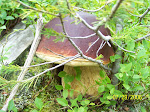We found this mushroom the same day as the Snowbank False Morel. We were finished hiking and were driving back down the Forest Service Road when we spotted some wood on the ground that was salvagable for firewood back home. A quick inspection of the area revealed this lovely little specimen, one we have never identified, or even seen before. After getting some photos in the wild we picked it and after looking through the guidebooks we were pretty sure of what it was just a little later.

The blue in the background here is the foot of our youngest mushroom hunter, lil' Cianen at just over sixteen months, being held back. And while there are some connoisseurs who enjoy eating this and don't have to deal with the lack of muscualar coordination this fungi can sometimes bring on, Cianen is currently of the belief that anything is edible, especially if our backs are turned.


The name that the scientist folk have labeled this with is Ptychoverpa bohemica. Or is it just Verpa bohemica? Well I thought it was the former when labeling the photos below, but it turns out that is what they call the exact same mushroom over in Europe. Here it is just plain ol' Verpa bohemica. So the ptyhco part (if you go by it) means cratered. Verpa has to do with the baby makin' organ of a man, and bohemica? Well, it seems to be taken from the word bohemia which usually means an artistic somebody a little out of the norm in their social functions.
As far as its more common name it has two. The Wrinkled Thimble Cap and the Early Morel. The first is pretty obvious. The second means that the yummy true morels are on their way! This mushroom pops up about 2 to 4 weeks ahead of their prized cousins. Oh boy!

One way of telling that is not a true morel is that it is not totally hollow. It is filled with wispy cotton candy like stuff. Another is that the cap is free. It is only attached at the top of the mushroom, while a true morel will be attached at the bottom of the cap or half way up, as it is on the Half-Free Morel.

 So after almost a full day of having her she decided to name the kitten Elizibeth because for some reason that I have not yet seen "She reminds me of Lizzy from Pride and Prejudice". How cute is that?
So after almost a full day of having her she decided to name the kitten Elizibeth because for some reason that I have not yet seen "She reminds me of Lizzy from Pride and Prejudice". How cute is that?















